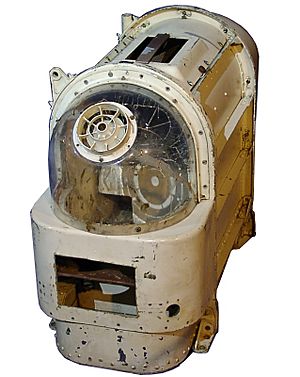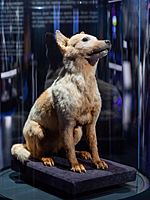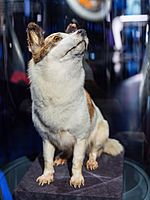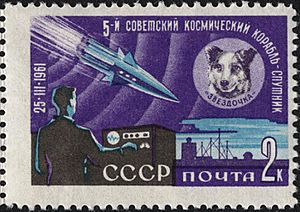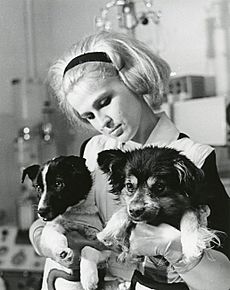Soviet space dogs facts for kids
During the 1950s and 1960s, the Soviet space program used dogs for space flights. These flights helped scientists learn if humans could survive in space. Dogs went on both sub-orbital (up and down) and orbital (around Earth) trips.
Scientists often chose female dogs because their bodies fit the spacesuits better. They also picked mixed-breed dogs. These dogs seemed tougher and better able to handle the challenges of space travel.
The Soviet Union sent at least 57 dogs into space. Some dogs flew more than once. Most of them survived their missions. The few that died usually did so because of technical problems with the rockets or spacecraft. A famous exception was Laika. She was the first animal to orbit Earth in 1957. Her death was expected from the start of her Sputnik 2 mission.
Training Space Dogs
Scientists chose dogs for these experiments because they believed dogs could stay still for long periods. This was important for space travel.
As part of their training, dogs were kept in small boxes for 15 to 20 days at a time. Stray dogs were preferred over house pets. Scientists thought strays would handle the tough conditions of space flight better. Female dogs were used because of their calm nature. Also, the special suits they wore to collect waste were designed for females.
Their training included many steps. They learned to stand still for a long time. They wore space suits and were placed in simulators. These simulators acted like a rocket during launch. Dogs also rode in centrifuges. These machines spun them around to copy the strong forces of a rocket launch. They were kept in smaller and smaller cages to get used to the tight space inside the rocket.
Dogs that flew into orbit ate a special jelly-like protein. This food was high in fiber. It helped the dogs go to the bathroom during long flights in their small space modules. After returning to Earth, more than 60% of the dogs had problems like constipation or gallstones.
Sub-orbital Space Flights
Sub-orbital flights mean the rocket goes up into space and then comes back down. It does not go all the way around Earth.
From 1951 to 1956, dogs flew on 15 scientific flights. These flights used R-1 rockets and went up to 100 kilometers (about 62 miles). The dogs wore special pressure suits with clear helmets. From 1957 to 1960, 11 more flights carried dogs. These used R-2A rockets and went up to about 200 kilometers (about 124 miles). Three flights in 1958 used R-5A rockets and reached about 450 kilometers (about 280 miles). In the R-2 and R-5 rockets, the dogs stayed inside a pressurized cabin.
Dezik, Tsygan, and Lisa-1
Dezik and Tsygan were the first dogs to make a sub-orbital flight. This happened on August 15, 1951. Both dogs were found safe after flying to 110 kilometers (about 68 miles). Dezik flew again later in 1951 with a dog named Lisa. Sadly, neither survived this second flight because their parachute did not open. After Dezik's death, Tsygan became a pet for a Soviet scientist named Anatoli Blagonravov.
Smelaya and Malyshka
Smelaya ("Brave") was supposed to fly in September. But she ran away the day before the launch! She was found the next day. Smelaya then made a successful flight with a dog named Malyshka ("Baby"). Their rocket crashed because the parachute did not open. But the recovery team found them alive the next day.
Bobik and ZIB
Bobik ran away just days before his flight on September 15, 1951. A replacement dog named ZIB was quickly found. ZIB was an untrained street dog running near the barracks. He made a successful flight to 100 kilometers (about 62 miles) and returned safely. ZIB's name was a Russian acronym meaning "Substitute for Missing Bobik."
Otvazhnaya and Snezhinka
Otvazhnaya ("brave one") flew on July 2, 1959. She flew with a rabbit named Marfusha and another dog named Snezhinka ("Snowflake"). Otvazhnaya went on to make 5 more flights between 1959 and 1960.
Damka and Krasavka
Damka and Krasavka ("little beauty") were supposed to orbit Earth on December 22, 1960. This mission was part of the Vostok programme. But their mission had many equipment problems.
The rocket's upper part failed. The spacecraft came back into Earth's atmosphere after reaching 214 kilometers (about 133 miles). If it returned unexpectedly, the craft was supposed to eject the dogs and then destroy itself. But the ejection seat failed, and the main self-destruct system broke. So, the animals were still inside the capsule when it landed.
A backup self-destruct system was set to go off in 60 hours. A team quickly went to find the capsule. They found it in deep snow on the first day. But it was too dark to disarm the self-destruct or open the capsule. The team reported that the window was frozen in the very cold −45°F (−43°C) temperatures. They saw no signs of life. But on the second day, when the capsule was opened, the dogs were heard barking! The dogs were wrapped in warm sheepskin coats and flown to Moscow alive. All the mice on board had died from the cold.
Damka was also called Shutka ("Joke") or Zhemchuzhnaya ("Pearly"). Krasavka was also known as Kometka ("Little Comet") or Zhulka ("Cheater"). After this amazing survival, Krasavka was adopted by Oleg Gazenko. He was a top Soviet scientist who worked with space animals. She had puppies and lived with Gazenko's family for 14 years.
Bars and Lisichka
Bars ("snow leopard") and Lisichka ("little fox") were also on a mission to orbit Earth. This was part of the Vostok programme. But they died when their rocket exploded 28.5 seconds after launch on July 28, 1960. Bars was also known as Chayka ("seagull").
Other dogs that flew on sub-orbital flights include Dymka ("smoky"), Modnitsa ("fashionista"), and Kozyavka ("booger").
Orbital Space Flights
Orbital flights mean the spacecraft goes all the way around Earth.
Laika: The First Orbiter
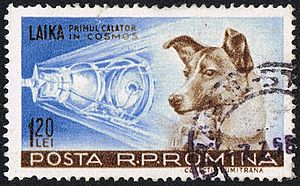
On November 3, 1957, a dog named Laika ("barker") flew into space on Sputnik 2. She became the first living creature from Earth (besides tiny microbes) to orbit the planet. Before her, many animals had flown on sub-orbital flights, like the rhesus monkey Albert II in 1949. Laika was also called Zhuchka ("Little Bug") and Limonchik ("Little Lemon"). American news reporters called her "Muttnik," playing on the name Sputnik.
Laika died between five and seven hours into her flight. This was due to stress and overheating. The real reason for her death was not made public until October 2002. Before that, officials said she died when her oxygen ran out. In 1998, Oleg Gazenko, a scientist involved in the project, said he regretted Laika's death. He felt they did not learn enough from the mission to justify losing the dog.
Belka and Strelka: The Survivors
Belka ("squirrel" or "Whitey") and Strelka ("little arrow") spent a day in space. They were aboard Korabl-Sputnik 2 (Sputnik 5) on August 19, 1960. They safely returned to Earth. They were the first higher living organisms to survive orbiting in outer space.
They were not alone! A grey rabbit, 42 mice, two rats, flies, and several plants and fungi joined them. All the passengers survived. Belka and Strelka were the first Earth-born creatures to go into orbit and come back alive. They later had many puppies.
Pchyolka and Mushka
Pchyolka ("little bee") and Mushka ("little fly") spent a day in orbit on December 1, 1960. They were on board Korabl-Sputnik-3 (Sputnik 6) with other animals, plants, and insects. During their return, the retrorockets (which slow the spacecraft down) did not shut off as planned. To stop foreign countries from getting the capsule, it was purposely destroyed by remote control.
Mushka was one of the three dogs trained for Sputnik 2. She was used in ground tests. She did not fly on Sputnik 2 because she refused to eat properly.
Chernushka
Chernushka ("Blackie") made one orbit on board Korabl-Sputnik-4 (Sputnik 9) on March 9, 1961. She flew with a cosmonaut dummy (nicknamed Ivan Ivanovich), mice, and a guinea pig. The dummy was ejected from the capsule during re-entry and landed softly with a parachute. Chernushka was found safe inside the capsule.
Zvyozdochka
Zvyozdochka ("starlet") was named by the famous astronaut Yuri Gagarin. She made one orbit on board Korabl-Sputnik 5 on March 25, 1961. She flew with a wooden cosmonaut dummy. This was the final practice flight before Gagarin's historic flight on April 12. Again, the dummy was ejected, while Zvyozdochka stayed inside the capsule. Both were recovered successfully.
Veterok and Ugolyok: Longest Dog Flight
Veterok ("light breeze") and Ugolyok ("ember") were launched on February 22, 1966. They were on board Cosmos 110. They spent 21 days in orbit before landing on March 16. This was a record-breaking spaceflight for its length. No human stayed in space longer until the Soyuz 11 mission in June 1971. It is still the longest space flight ever made by dogs.
The two dogs showed signs of being weak after the flight. They were dehydrated, lost weight, and had problems with their muscles and coordination. It took several weeks for them to fully recover. But they did not have any long-term health problems.
See also
 In Spanish: Perros del programa espacial soviético para niños
In Spanish: Perros del programa espacial soviético para niños
- Animals in space
- Cosmo (comics)
- Félicette, first cat in space
- List of individual dogs
- Monkeys and non-human apes in space
- Museum of Jurassic Technology, which has an eternal flame dedicated to Laika and a portrait gallery of the USSR's space dogs
- Sputnik program
- Voskhod program


